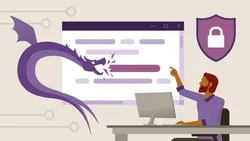
Kali Linux Basic Course 
This Kali Linux Basic Course covers the fundamentals of the Kali Linux operating system. It starts with an introduction to the system, followed by a look at the file structure, desktop environment, installation in VMware, updating Kali, and installing VMware tools in Kali. Students will gain a comprehensive understanding of the system and its capabilities. ▼
ADVERTISEMENT
Course Feature
![]() Cost:
Cost:
Free
![]() Provider:
Provider:
Youtube
![]() Certificate:
Certificate:
Paid Certification
![]() Language:
Language:
English
![]() Start Date:
Start Date:
On-Demand
Course Overview
❗The content presented here is sourced directly from Youtube platform. For comprehensive course details, including enrollment information, simply click on the 'Go to class' link on our website.
Updated in [May 25th, 2023]
Kali Linux is a powerful open-source operating system designed for digital forensics and penetration testing. This course provides an introduction to the basics of Kali Linux, including its file structure, desktop environment, installation in VMware, and updating. Learners will gain an understanding of the fundamentals of the operating system, as well as the skills to use it for digital forensics and penetration testing.
This course is ideal for those who are new to Kali Linux and want to learn the basics. It covers topics such as the file structure, desktop environment, installation in VMware, and updating. Learners will gain an understanding of the fundamentals of the operating system, as well as the skills to use it for digital forensics and penetration testing. Additionally, the course provides an overview of the development paths available for those who want to further their knowledge and skills in the field. Related learning suggestions are also provided to help learners find the best resources for their needs.
[Applications]
The application of this Kali Linux Basic Course can be seen in various areas. It can be used to gain a better understanding of the Linux operating system, its file structure, and its desktop environment. It can also be used to learn how to install Kali Linux in a virtual machine, as well as how to update it and install VMware tools. Additionally, this course can be used to gain a better understanding of the security tools available in Kali Linux, and how to use them to protect a system from malicious attacks.
[Career Paths]
1. Cyber Security Analyst: Cyber Security Analysts are responsible for monitoring and protecting computer networks and systems from cyber threats. They use a variety of tools and techniques to identify, analyze, and respond to potential security threats. As the demand for cyber security professionals continues to grow, the job outlook for this position is very promising.
2. Penetration Tester: Penetration Testers are responsible for testing the security of computer systems and networks. They use a variety of tools and techniques to identify and exploit vulnerabilities in order to assess the security of the system. This position requires a strong understanding of computer networks and systems, as well as the ability to think critically and creatively.
3. Network Administrator: Network Administrators are responsible for managing and maintaining computer networks. They use a variety of tools and techniques to configure, monitor, and troubleshoot networks. This position requires a strong understanding of computer networks and systems, as well as the ability to think critically and creatively.
4. System Administrator: System Administrators are responsible for managing and maintaining computer systems. They use a variety of tools and techniques to configure, monitor, and troubleshoot systems. This position requires a strong understanding of computer systems, as well as the ability to think critically and creatively. As the demand for IT professionals continues to grow, the job outlook for this position is very promising.
[Education Paths]
1. Bachelor of Science in Cybersecurity: This degree path focuses on the technical aspects of cybersecurity, such as network security, cryptography, and digital forensics. It also covers the legal and ethical aspects of cybersecurity, such as data privacy and compliance. This degree path is becoming increasingly popular as the demand for cybersecurity professionals grows.
2. Master of Science in Information Security: This degree path focuses on the management and leadership aspects of cybersecurity, such as risk management, policy development, and incident response. It also covers the technical aspects of cybersecurity, such as network security, cryptography, and digital forensics. This degree path is becoming increasingly popular as organizations look for professionals with the skills to lead their cybersecurity teams.
3. Doctor of Philosophy in Cybersecurity: This degree path focuses on the research aspects of cybersecurity, such as developing new technologies and techniques to protect networks and systems. It also covers the legal and ethical aspects of cybersecurity, such as data privacy and compliance. This degree path is becoming increasingly popular as organizations look for professionals with the skills to develop new solutions to protect their networks and systems.
4. Master of Business Administration in Cybersecurity: This degree path focuses on the business aspects of cybersecurity, such as risk management, policy development, and incident response. It also covers the technical aspects of cybersecurity, such as network security, cryptography, and digital forensics. This degree path is becoming increasingly popular as organizations look for professionals with the skills to lead their cybersecurity teams and manage their cybersecurity budgets.
Course Provider

Provider Youtube's Stats at AZClass
Discussion and Reviews
0.0 (Based on 0 reviews)
Explore Similar Online Courses

Getting Help with PowerShell

The Complete Cryptocurrency Fundamentals for Beginners Guide

Python for Informatics: Exploring Information

Social Network Analysis

Introduction to Systematic Review and Meta-Analysis

The Analytics Edge

DCO042 - Python For Informatics

Causal Diagrams: Draw Your Assumptions Before Your Conclusions

Whole genome sequencing of bacterial genomes - tools and applications

Learning Kali Linux

Learning Kali Linux on Windows

Learning Kali Linux
 Related Categories
Related Categories
 Popular Providers
Popular Providers
Quiz
 Submitted Sucessfully
Submitted Sucessfully
1. What is the main purpose of Kali Linux?
2. Which of the following is a part of Kali Linux?
3. Which of the following is NOT a part of Kali Linux?
4. What is the purpose of Kali Linux?
Correct Answer: It is a Debian-based Linux distribution designed for digital forensics and penetration testing.


Start your review of Kali Linux Basic Course